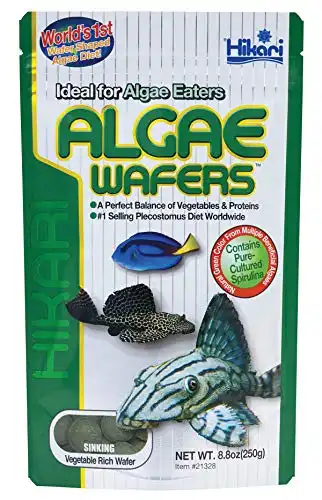Thank you for visiting! By the way… any links on this page that lead to products on Amazon and other stores/partners are affiliate links Aquarium Store Depot earns a commission if you make a purchase.
In this article, we’re talking all about bottom feeders, and I don’t mean that as an insult! Bottom feeder fish fill an important role in the home aquarium. On top of that, these fascinating fish look great and often have awesome personalities too.
So let’s get started learning all about the best types of bottom-feeder fish for your aquarium and how to care for them.
What Are Bottom Feeders?
Bottom feeder fish are fish that spend most of their time at the bottom of the tank. Bottom feeders are some of my favorite species out there because they often have very interesting looks and behaviors.
Some species are fast and active, but many can be pretty inactive and some species are shy and difficult to see. They can be super useful in your aquarium though because they are happy to feed on food that has sunk to the bottom of the tank.
Each species does have its own preferred diet of course, and it’s important that you make sure that they are well fed (more on this later).
The Benefits Of Bottom Feeders
Bottom-feeder species are great for adding activity and life to the bottom of your aquarium. This can make your tank a much more lively environment that is even more fascinating to observe!
Apart from their interesting looks and behaviors, bottom-feeder fish have a bunch of benefits in the tank. Some species like the Otocinclus catfish are master tank cleaners because they feed on the algae that grow on the walls of fish tanks and the ornaments inside them.
Other bottom feeders like Cory Catfish feed by searching the substrate and any tight spaces in the aquarium for uneaten food which helps to keep your tank clean.
The Nine Best to Choose From
There are so many great bottom feeders out there, but these are definitely the favorites that I can recommend to any fishkeeper. Remember to take note of their needs to make sure they will work out in your tank! I’ve also included a few common bottom feeders that you should avoid.
Check out our video below from our YouTube channel. If you like this content, subscribe to our channel for additional videos. We are releasing videos every week. We go into more detail in the blog post below.
1. Corydoras Catfish
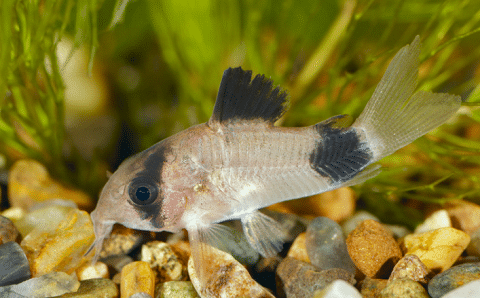
- Scientific Name: Corydoras spp.
- Adult Size: 1-3 Inches
- Care Level: Easy
- Temperament: Peaceful
- Minimum Tank Size: 10 + gallons for dwarf species, 20+ gallons for others
- Diet: Omnivorous, feed live and frozen foods, Sinking pellets and wafers
- Origin: South America
- Temperature: 72 – 82°F
- Swimming Level: Bottom
Cory Catfish or Corydoras are great little schooling catfish for the community tank. These bottom feeders for freshwater aquariums are a favorite in the aquarium hobby and there are many different species to choose from.
Some species like the Dwarf Cory Catfish and the Pygmy Cory Catfish can be kept in nano aquariums as small as a 10 gallon fish tank. Most Corydoras catfish species will prefer a 20 gallon tank or larger though. They are social fish so be sure to keep at least 6 together in the same aquarium.
Cory cats are great fun to watch as they cruise around the tank together, feeding on food lying on and in the substrate. A common mistake that fishkeepers make is to think that you don’t need to feed these fish. In fact, Cory catfish do best on a balanced diet of dried and live/frozen foods.
2. Otocinclus Catfish

- Scientific Name: Otocinclus spp.
- Adult Size: 2 inches
- Care Level: Moderate
- Temperament: Peaceful
- Minimum Tank Size: 10+ gallons
- Diet: Algae
- Origin: South America, Venezuela, Argentina
- Temperature: 70-74°F
- Swimming Level: Bottom, midwater, Top
Otos are very peaceful fish for the community tank. These little catfish are algae eaters, which means they are great for keeping your glass and ornaments clean. These nano fish are very popular in the aquarium trade and will do very well as long as you are able to maintain good water quality.
Mature aquariums with a healthy amount of algae provide the best aquatic environment for this fish species. You can also supplement their diet with algae wafers and slices of vegetables like zucchini.
3. Dojo Loach

- Scientific Name: Misgurnus anguillicaudatus
- Adult Size: 10 inches
- Care Level: Easy
- Temperament: Peaceful
- Minimum Tank Size: 55+ gallons
- Diet: Omnivorous, feed live and frozen foods, Sinking pellets and wafers
- Origin: Asia, China, Japan, Korea, Russia
- Temperature: 59-77°F
- Swimming Level: Bottom
Dojo Loaches are great fish for larger aquariums. These fish have the interesting habit of increasing their activity levels when the weather is changing, kind of like your own little weather forecaster! This has earned them the name of weather loach as well.
Apart from just the regular Dojo Loach, there is also a golden variety available in the hobby. These fish are active bottom feeders that love to search the substrate for uneaten food at the bottom of the tank.
4. Bristlenose Pleco

- Scientific Name: Ancistrus cirrhosus
- Adult Size: 5 inches
- Care Level: Easy
- Temperament: Semi-agressive
- Minimum Tank Size: 20 + gallons
- Diet: Vegetarian, Algae
- Origin: South America
- Temperature: 73-81°F
- Swimming Level: Bottom
Bristlenose Pleco fish are super interesting-looking catfish that fit in perfectly with most community tanks. They are peaceful bottom-dwelling fish, although they do tend to be aggressive towards other members of the same species.
For this reason, it’s better not to keep more than one adult in the same tank. These amazing bottom dwellers do a great job of keeping the tank clean by searching the substrate for algae and food leftovers.
5. Clown Pleco
- Scientific Name: Panaqolus maccus
- Adult Size: 3.5 inches
- Care Level: Moderate
- Temperament: Peaceful
- Minimum Tank Size: 20+ gallons
- Diet: Vegetarian, feed vegetables and algae wafers
- Origin: South America, Venezuela
- Temperature: 73-82°F
- Swimming Level: Bottom
These beautiful bottom-feeder fish (video source) need plenty of driftwood in their tank to feed on. They love slices of vegetables like zucchini and cucumbers and also enjoy frozen foods.
These fish are very peaceful and do great in community tanks. They do produce quite a lot of waste though so the tank does need to have decent filtration.
6. Freshwater Shrimp
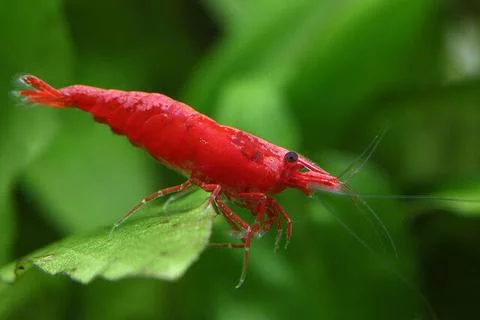
- Scientific Name: Caridina & Neocaridina spp.
- Adult Size: 1.5-2 inches
- Care Level: Easy-Moderate
- Temperament: Peaceful
- Minimum Tank Size: 5+ gallons (20+ gallons recommended)
- Diet: Omnivorous, Algae, Sinking flakes & Pellets
- Origin: Asia, North America
- Temperature: 70-74°F
- Swimming Level: Bottom
The freshwater shrimp is an amazing aquatic animal that has become incredibly popular in the modern fish-keeping hobby. There are loads of different species available, and some eat algae while others will prefer pellet foods.
Shrimp will only get along with a few types of fish like Otocinclus catfish. Most carnivorous and omnivorous fish will see your shrimp as a food source, so many hobbyists prefer to keep shrimp-only tanks to be on the safe side.
7. Kuhli Loach
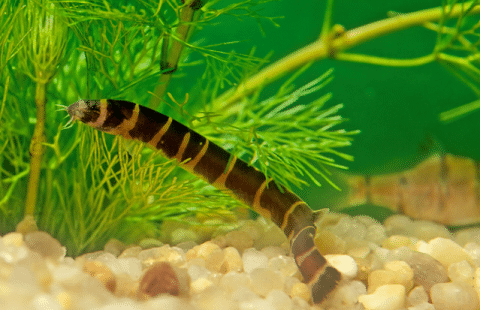
- Scientific Name: Pangio Kuhlii
- Adult Size: 4 inches
- Care Level: Moderate
- Temperament: Peaceful
- Minimum Tank Size: 20+ gallons
- Diet: Omnivorous, Feed sinking pellets, wafers, and frozen foods
- Origin: Southeast Asia
- Temperature: 73-86°F
- Swimming Level: Bottom
Kuhli Loaches are great-looking little bottom feeders. This fish species has some really silly antics and is great fun to watch when not hiding. They are nocturnal fish and tend to hide out during the day so you won’t see them every time you take a look at your tank.
Kuhli loaches are one of the best bottom-feeder fish in the hobby. They use their whiskers to locate food on the bottom of the tank and do a great job of picking up scraps of uneaten fish food. These fish will do best in a group of at least five. They should be kept on a sand or fine gravel substrate and love plenty of hiding spaces in the tank.
8. Panda Garra
- Scientific Name: Garra flavatra
- Adult Size: 3 inches
- Care Level: Moderate
- Temperament: Peaceful
- Minimum Tank Size: 20+ gallons
- Diet: Omnivorous, feed wafers, and frozen foods
- Origin: Southeast Asia
- Temperature: 70-74°F
- Swimming Level: Bottom
Panda Garras are very peaceful fish that prefer high flow tank conditions (video source). They are pretty new to the fish-keeping hobby but already very popular. They are actually Cyprinids from the carp species family.
Panda Garras get their name from their bold, panda-like stripes. These fish feed on biofilm and algae that grow on rocks at the bottom of the tank, but you should supplement their diet with some frozen foods and wafers for a balanced diet.
9. Clown Loach
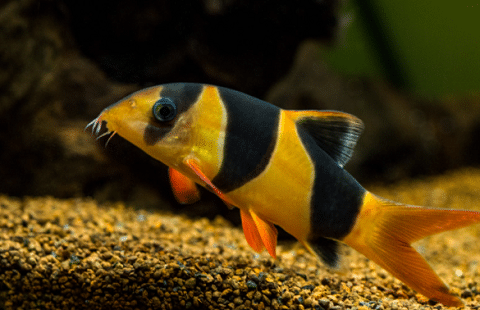
- Scientific Name: Botia macracantha
- Adult Size: 12 inches
- Care Level: Moderate
- Temperament: Peaceful
- Minimum Tank Size: 100 gallons
- Diet: Carnivorous
- Origin: Southeast Asia, Indonesia, Borneo, Malaysia, Sumatra
- Temperature: 70-74°F
- Swimming Level: Bottom
Clown Loaches are a really cute bottom-feeder fish species for large aquariums. They are active but very peaceful fish that are great in community tanks. These fish like to school, so make sure you have at least 4 of them in the same aquarium. They are also great snail eating fish.
Other Great Types To Consider
Below is a list of honorable mentions. They are as popular or provide as much utility as the ones above, but are worth mentioning. Check them out below:
- Synodontis catfish- This is a great bottom feeder for African cichlid tanks in particular.
- Siamese Algae Eater– These active algae-eaters are great bottom feeders for community tanks. Keep these fish in groups of 5 or more in a 40-gallon tank or larger.
- Twig Catfish- These are some of the most interesting looking bottom-feeding fish in the hobby. They grow to 6 inches in length but are safe to keep with small, peaceful community fish.
- Pictus Catfish– These interesting little South American catfish are peaceful but very shy fish. They have pretty big mouths and will eat any small fish in your tank, so make sure they are the smallest fish in the aquarium.
- Yoyo Loach-These fish have markings on their sides that look just like the word yoyo. They are mostly peaceful but will love snacking on shrimp and snails in the tank.
- Zebra Loach– These are great little freshwater bottom-feeders for the community tank. The zebra loach is a peaceful fish that grows to just 4 inches or so.
Bottom Feeders To Avoid
Not all bottom feeder fish are suitable for your standard home aquarium. The following few species are not great choices for most fishkeepers:
Common Pleco – Hypostomus plecostomus
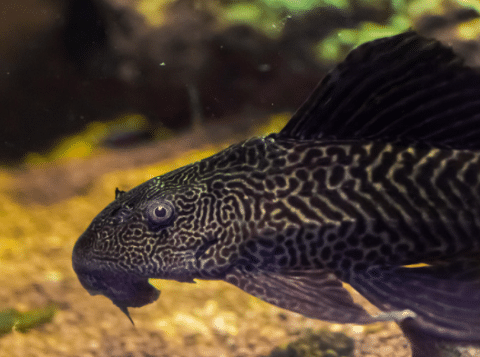
The Common Pleco is one of those fish that are probably more popular than they should be. These bottom-feeding fish can grow to sizes of over 20 inches in length which comes as a surprise to many fish keepers.
This is an easy mistake to make because they usually measure just a few inches in length when you see them at your local fish store. Unfortunately, these fish are often released into local ponds and rivers when they get too big, and they have become quite a nuisance in the wild1.
They are great fish, but only for keepers with very large tanks who can take care of them properly.
Chinese Algae Eater – Gyrinocheilus aymonieri
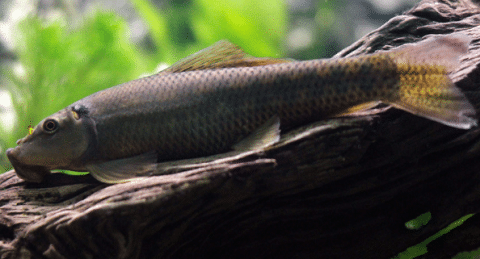
The Chinese Algae Eater grows to about 10 inches or a little more in length. These fish grow fast and catch a lot of fishkeepers off guard when they get too big for their tank.
They are good algae eaters but have a tendency to get pretty aggressive towards other fish in the tank. In fact, Chinese algae eaters will even attack other fish to eat the slime coating off of their skin and scales.
These aren’t very good-looking fish either and you’re much better off choosing another fish from our list!
Tiger Shovelnose Catfish – Pseudoplatystoma fasciatum

The Tiger Shovelnose Catfish is a really cool-looking fish that many people have made the mistake of buying. It’s hard to imagine that the 4-inch long little cutie you just brought home can grow to over 3 feet in length!
These catfish are carnivorous and have big mouths. This means the rest of your fish are going to be eaten as soon as the Tiger Shovelnose is big enough to swallow them.
Avoid this species unless you have a very large aquarium (200 gallons), and are prepared to care for a very large carnivorous catfish!
How To Set Up Your Tank
Before buying any bottom-feeding fish, it’s really important to read up on its needs. Here is some basic information on setting up for bottom-feeding fish:
Filtration
Running a good quality filter in your aquarium is absolutely essential. Some fishkeepers make the mistake of thinking their bottom feeder fish will keep the tank clean so they don’t need a filter. Big mistake!
But which kind of filter should you choose? There are many options available, but as a general rule, pick a model that can process all the water in your tank at least 4 times every hour.
Some bottom-feeder fish like the Panda Garra like a stronger current in the tank, and for them, you can bump up the flow rate to as much as 10 times your tank volume per hour.
Water Quality
Good water quality is what keeps fish happy and healthy in your aquarium. Remember, your pets rely on you to provide them with a great environment to live in.
Once you’ve set up your tank and got your filter running, you’re going to want to start the process of fishless cycling. Once your tank is cycled and you have stocked it with some great fish, you’re going to want to get into the routine of performing a regular partial water change.
This means taking out a percentage of the water in your tank every week or two and replacing it with new water that you have treated with a conditioner. The amount of water you need to replace is going to depend on a couple of things like:
- The size of your aquarium
- How heavily stocked you are
- The bioload of your fish
- Whether you have live plants in the tank
- How powerful your filtration is
Testing Your Water
In order to know how stable your water quality is in the aquarium, and whether you’ve successfully cycled the tank, you’re going to need to test for a few parameters on a regular basis.
This is easy to do using a liquid test kit. Test the water before you do your regular water changes to know whether you’re performing regular and large enough water changes.
Substrates
Your choice of substrate can be pretty important for the health of your fish. This is especially true when it comes to bottom dwellers because they spend most of their time down on the bottom of the tank.
Sure, bottom-feeder fish can be kept in open bottom tanks, but this prevents them from acting out a lot of their natural behaviors and will probably leave them feeling seriously exposed.
Instead, choose a fine substrate like sand that allows these fish to dig through and forage in safely. Avoid using sharp substrates that can injure your fish.
Natural sand is excellent for bottom feeder fish to forage around in.
Many bottom-feeder fish like loaches and cory catfish have fine whiskers known as barbels. Sharp gravel can damage these ultra-sensitive structures that are used to feel the substrate to find food.
Some bottom-feeder fish like the Kuhli Loach do not have scales and can get their skin scratched up on sharp substrates while digging through it. This can cause infections.
Hiding Places and Decorations
Bottom-feeder fish are often shy creatures that love having caves and other hiding places to hang out in. You can build your own caves out of rocks if you like, just make sure that your structure is safe and stable.
Driftwood that has holes in it, clay flowerpots, and purpose-built aquarium cave ornaments are other great ways to provide hiding places for your fish. Some bottom-dwellers, like Kuhli Loaches, will even dig themselves into the substrate to hide away and find shelter.
The Planted Aquarium
Growing live plants is a great way to make a really natural and healthy environment for your freshwater bottom-feeders and other fish. Keeping a planted tank can be really easy if you grow plants like Anubias and Java Ferns that don’t need any special equipment. Plants also create great places for your bottom-feeder fish to hide and look for food.
What To Feed
Bottom-feeder fish need to be fed a high-quality, balanced diet. Of course, different types of fish have different diets, but here are a few of the best food options available for your fish:
Frozen foods
Frozen foods are great for omnivorous and carnivorous bottom-feeder fish. Brine shrimp, bloodworm, and daphnia are all good examples of this food type. Frozen foods should not be the primary food source for your bottom-feeder fish but can be a great supplement.
Live foods
Live foods like brine shrimp, daphnia, micro worms, and mosquito larvae are great food sources for carnivorous and omnivorous fish. Fish love live food so much that it usually doesn’t get to the bottom of the tank before your other fish eat it all!
Live Algae
Algae eaters like Otocinclus Catfish, Siamese Algae Eaters, and Plecos have a natural diet of algae. This is great because they are able to get a healthy meal and keep your aquarium clean at the same time! Algae grow in all mature fish tanks, especially tanks with bright light and a lot of nutrients in the water.
Algae Wafers
Algae wafers can be a great supplementary food source for omnivorous and algae-eating fish like Clown Plecos, Otos, and Siamese Algae Eaters. Look for brands like Hikari when search for a wafer.
Algae wafers are a great way to directly feed your bottom feeding fish. They are especially effective for larger fish like plecos
Shrimp Food
Most shrimp are omnivorous creatures and there are plenty of excellent products available that are designed specifically for their needs. Shrimp food is available in gel, pellet, wafer, and stick form.
Pellets
These sinking pellets provide balanced nutrition for all sorts of omnivorous aquarium fish. There are plenty of good quality products available on the market, just make sure you choose something that is the right size for your fish.
Vegetables
Herbivorous fish like Otos and Bristlenose Plecos love vegetables. Sliced cucumbers and zucchinis are great options, but you can also use blanched peas, broccoli, and cabbage for variety.
Where To Buy
Most fish stores have a good variety of bottom-feeding fish for freshwater aquariums. These days, many fishkeepers prefer the convenience of buying online.
My favorite online retailer is Flipaquatics because they offer a great range of fish at great prices. They also fully quarantine their livestock. They really care for their stock and their 100% live arrival guarantee takes so much of the stress out of buying and transporting new pets. For larger fish, check out the link above for other fish retailers.
FAQS
Is this type of fish good?
Bottom feeder fish are awesome pets that can be very helpful in keeping your freshwater aquarium clean. There are a few types of bottom-feeder fish that you should avoid, but as long as you choose the right kinds for your tank, they will do great!
Do they eat fish poop?
Bottom-feeder fish do not eat fish poop, but rather need a good quality balanced diet. Unfortunately, you still need to clean and vacuum your tank, even if you have bottom-feeder fish.
What do you feed them?
Different bottom-feeder fish have different diets, depending on their species. Most types of bottom feeders can be fed on granules, pellets, wafers, sliced vegetables, and live and frozen foods.
What Fish Can Live With This Type?
Almost all fish can live with bottom feeders. You just have to make sure that they all enjoy the same parameters, are peaceful and are similar in size.
What is the best bottom cleaner fish?
There are loads of great bottom-feeder fish available in the fish-keeping hobby. Any of the fish in this list of the 9 best bottom-feeder fish could work awesome in your freshwater aquarium.
Final Thoughts
Bottom feeder fish have a place in pretty much any home aquarium. These fish are fun to watch, look great, and work hard to keep your tank clean. If you don’t already have a few bottom feeders in your fish tank, why not pick some from our list and add them to your tank today?
I hope you’ve enjoyed the article and please comment below if you have any questions!
- About the Author
- Latest Posts
I’m thrilled that you found Aquarium Store Depot! Here you’ll find information on fish, aquariums, and all things aquatics related. I’m a hobbyist (being doing this since I was 11) and here to help other hobbyists thrive with their aquariums! I adhere to a high quality Editorial Process and Review products with real life field usage and practical analysis.



